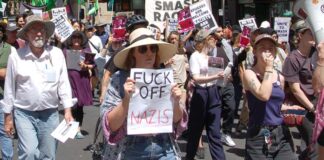In a disgraceful political stunt, Immigration Minister Chris Bowen has announced new laws to strip asylum seekers of visa rights. This is a further effort to blame asylum seekers for the detention crisis of the government’s own creation.
It follows hunger strikes at Curtin detention centre and a rooftop protest and chaos at Villawood.
The government wants to re-introduce temporary visas for any asylum seeker convicted of a criminal offence in detention, in an effort to punish protesters. This is a return to the Howard policy of temporary protection visas—which Labor scrapped in 2007.
A temporary visa would deny refugees the right to bring family members to Australia, and allow the government to deport them if it decides conditions in their country have “improved”.
Howard’s temporary visa system was a policy stolen straight from Pauline Hanson. Refugees were left in limbo for a further three to five years after they were accepted as refugees, when they had to reapply for refugee status. Only then would they find out whether they could stay.
Studies by mental health experts concluded this left refugees with “intense and disabling fear and terror about their future”.
This move comes in the wake of a media campaign against asylum seekers at Sydney’s Villawood detention centre, who burnt down several buildings during a protest.
The media denounced them as “criminals” and the government responded by throwing 22 people into Silverwater prison. As Solidarity went to press a week later they had not been charged with anything—yet they were still being held in solitary confinement. Solicitor Stephen Blanks said they were, “locked down for 18 hours a day… There are no toothbrushes, no showers, not even any toilet paper.”
But it is the government’s own policies that are producing the protests and despair inside detention. Report after report by mental health experts has shown that the longer asylum seekers are left in limbo, not knowing what is happening to their claims, the more the risk of suicide, self harm and mental illness grows.
The time people are spending in detention is growing. Statistics from March show almost 800 asylum seekers had been there for over a year. When Labor came into office, it announced its aim was to limit detention to 90 days (although not on Christmas Island). Now about 85 per cent of asylum seekers in detention, almost 6000 people, have been there longer than that.
Serco guards cause chaos
Violence at the Christmas Island detention centre in March was sparked when Serco and the Federal Police decided to organise a “show of force” and attacked a peaceful protest.
At Villawood, there are suggestions that it was again the conduct of Serco guards that allowed the situation to escalate. Investigators from workplace safety watchdog Comcare, who visited the centre a few days before the protests, described it as a “basket case”, according to the Weekend Australian.
Three security guards currently working at the centre, who spoke to independent journalist Antony Loewenstein, said staff are routinely told to perform tasks for which they are not trained.
The protest this time began when 13 asylum seekers again took to the roof of the centre in protest. Later that night a protest of 100 asylum seekers set parts of the centre alight.
After a full week three men, Iranian Majid Parhizkar and Kurds Mahdi Darabi and Amir Morad Masoor, remained on the roof. Serco denied them food the whole time. Majid told the media, “None of us is going to come down while we don’t have hope for our future.”
Easter protests
About 250 protesters rallied outside the centre to support them on Easter Monday, exchanging chants of “freedom” with the rooftop protesters.
The rally coincided with a protest at Melbourne’s Maribyrnong detention centre and a convergence of 60 refugee supporters to WA’s remote Curtin detention centre.
Many of the activists at Curtin travelled for two days by bus from Perth. They had submitted applications to visit 100 asylum seekers between them, but Serco set out to lie and obstruct the visits.
In the days before their arrival, 700 asylum seekers signed a letter to Serco requesting a delegation from the activists be allowed into the centre to meet them.
When Serco announced it was changing visiting rules and only allowing one-on-one visits, asylum seekers refused the conditions and began a protest. At least 300 joined a hunger strike and sit in.
With about 1500 asylum seekers inside Curtin, Serco’s restrictions would have allowed only 56 people to see visitors. The refugee activists blockaded the road into the detention centre in solidarity, and 16 were arrested and issued with move on orders.
There have been more protests in Christmas Island too, with five men holding a rooftop protest for two days.
The protests in detention are evoking memories of the suffering caused by Howard’s detention regime. Under Howard, the refugee movement forced the dismantling of the detention regime—now we need to do it again.
By James Supple





